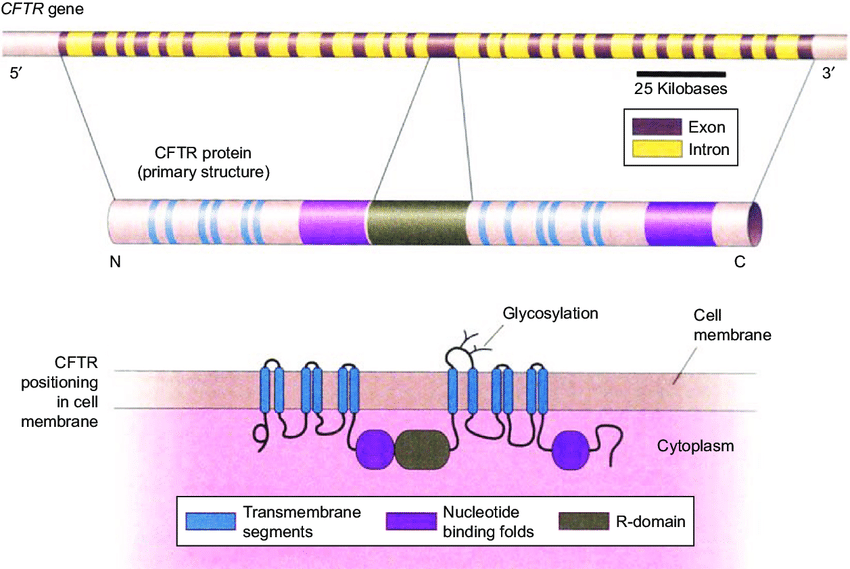The CFTR gene has multiple alterations, which means that the delta-F08 mutation is not the only known one. By the research, and resting on the information provided in the table, there are many other mutations of the CFTR gene that might cause the appearance and development of the disease (Freeman et al. 121). Thus, the mutation is a change in the DNA sequence that precondition the emergence of different versions of a gene or allelic variants (Freeman et al. 121). In such a way, the given list provides several CFTR genes that are impacted by the mutation and acquire new alleles. It means that people can suffer from the disease caused by different versions of the gene and its alleles.
The information provided in the table can help to acquire additional knowledge about the CFTR gene and its current variant. For instance, in CFTR, ARG1158TER, the first part describes the type of protein that is impacted. Another part stands for the changes in the arginine position. This means that ARG stands for arginine, 1158 for the position. In such a way, looking at the abbreviation, specialists can realize that the given CFTR mutation is characterized by the alteration of arginine position, TER indicates that the gene is close to the end of the p or q arm (the position in the chromosome).
Figure 1. CFTR Gene
Every gene has a unique structure that differentiates it from others. Thus, introns and exons are specific nucleotide sequences that can be found within every gene. The CFTR gene has 27 exons and 26 introns, which are graphically represented as coming one after another (See Figure 1). Introns are usually removed by RNA splicing and that are not expressed in mRNA products, while exons remain bonded to one another to created mature mRNA (Gillies and Hewitt 78). In such a way, exons and introns guarantee the appropriate functioning of the gene and coding of specific information, along with the transmission of traits (Freeman et al. 110). Under the impact of mutations, genetic sequences alter, and new variants with specific location of introns and exons emerge.
As far as there are many allelic variants of the CFTR gene, it is vital to realize the main features that differentiate them. For instance, CFTR, ILE507DEL, means that the 507th codon that codes for isoleucine is deleted. The absence of 507 unit preconditions the reduction of mRNA and change in CFTR protein, which means that another allelic variant is observed (“Cystic Fibrosis Transmembrane Conductance Regulator; CFTR”). For another type,.0020 CYSTIC FIBROSIS, CFTR 1-BP DEL 3659, other changes are peculiar. There is a deletion of C at nucleotide 3659 in exon 19 of the CFTR gene (“Cystic Fibrosis Transmembrane Conductance Regulator; CFTR”). It preconditions a frameshift and changes in mRNA that are associated with this factor. Both these alleles of the CFTR genes might cause the emergence and development of the disease.
In such a way, one can see that both CFTR, ILE507DEL, and CFTR 1-BP DEL 3659 are alleles of the same CFTR gene that emerge under the impact of the mutation. Regardless of the differences in their structure, the given genes still possess the opportunity to affect the work of proteins and the functioning of the body. The CFTR gene introduces specific instructions for generating cystic fibrosis transmembrane conductance regulator. This sort of protein is located in the membrane of cells producing mucus, sweat, tears, etc. In such a way, the gene preconditions the alterations in the work of this very protein, and secretions become thick, which affects the cell membrane and preconditions the evolution of the complex state.

Works Cited
Chaudary, Nauman. “Triplet CFTR Modulators: Future Prospects for Treatment of Cystic Fibrosis.” Therapeutics and Clinical Risk Management, vol. 14, pp. 2375-2383.
“Cystic Fibrosis Transmembrane Conductance Regulator; CFTR.” OMIM, 2020.
Freeman, Scott, et al. Biological Science, Third Canadian Edition. Pearson Canada. 2018.
Gillies, Sharon, and Sarah Hewitt. Biology on the Cutting Edge: Concepts, Issues, and Canadian Research around the Globe. Pearson, 2010.